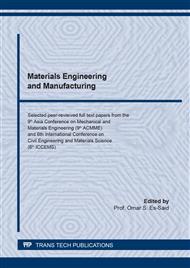p.97
p.103
p.111
p.120
p.128
p.134
p.143
p.151
p.158
Cytotoxicity of Ti/SS316/Mg Particles on Human Osteoblasts
Abstract:
Daily walking or exercise of the bone implant recipients may generate particles due to wear and tear. Reports have mentioned that particles could circulate in the human body and trigger aseptic loosening, inflammation, and other potential complications. The mechanism of these phenomena remains mostly unclear. This study is to investigate the cytotoxicity of titanium (Ti), stainless steel 316 (SS316), and magnesium (Mg) particles due to these materials are the most commonly used biomaterials based on their adequate mechanical properties and excellent biocompatibility. Human osteoblasts (SAOS2 cells) were exposed directly to different concentrations of Ti/SS316/Mg particle during the direct cytotoxicity test. Together with the previous study, we found out that Ti particles showed cytotoxicity to osteoblasts at different dosages and times, while SS316 particles and Mg particles (low dosage) can reduce the cytotoxicity induced by Ti particles and boost cell viability. Mg particles can be toxic to osteoblast at a higher dosage, while SS316 particles are “safer” than Mg particles at higher dosages. Cell viability and cell morphology of SAOS2 cells under different treatments were observed at 2/3/5 days. This study found out that cell viability could be enhanced with certain combinations of Ti/SS316/Mg particles. This can give us certain guideline on how to design and fabricate a hybrid bone implant. However, how to quantify the particles inside the human body in real-time, and the exact interaction among particles, cells, tissues, and even organs require further research.
Info:
Periodical:
Pages:
128-133
Citation:
Online since:
October 2021
Authors:
Keywords:
Price:
Сopyright:
© 2021 Trans Tech Publications Ltd. All Rights Reserved
Share:
Citation:


